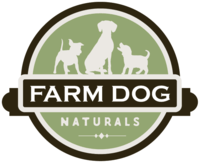Over the years, garlic for dogs has somehow gained this terrible reputation. Ask most pet parents what foods dogs absolutely can’t eat and you’re almost sure to hear these 4:
- onions
- grapes
- chocolate
- garlic
And while the first 3 are definite no-nos, how did garlic end up on the list?? Here are Farm Dog we’re huge fans of all types of herbs and foods. And garlic? Yes, it is on our list of beloved foods.
We’ll get to the many reasons we feed it, plus easy tips and recommended amounts for feeding, but first, let’s talk about how it came to be on that list of forbidden foods…
How Garlic Got its Bad Name?
Does garlic have its risks? Yes, there are a few warnings that come with garlic. But in general? If you dog eats a piece of garlic, do you need to rush to the vet?
Yes, too much garlic can harm your dog. “Too much” applies to all herbs. The only difference between help and harm is dosage. If used properly, garlic offers a myriad of health and disease preventing benefits.
Research based evidence of garlic’s toxicity is based on excessive and lethal doses of garlic as well as variant extracts and methodology. In one study, researchers used an equivalent of four full heads of garlic, or 60 cloves, and administered them to a 75 pound dog. This was definitely an overdose!
I think if I ate 60 cloves of garlic I would need a new stomach lining or my stomach pumped.
So, while a lot of garlic is problematic, smaller doses are not.
That said…
Warnings?
As far as specific warnings, here’s what you need to know. Certain dog breeds have genetically predisposed garlic sensitivities. They include: Akitas and Shiba Inus. These two breeds are sensitive to “hemolysis,” also referred to as Heinz Body hemoytic anemia. It’s a serious condition and reason for concern. Thiosulfates and N-propyl disulphide found in garlic break down red blood cells causing oxidation and early cell death. Thiosulfates are also found in chives, onions, and shallots.
If you suspect a breed issue or your dog might be garlic sensitive you can do genetic testing or talk to your holistic vet. If you’re feeding garlic and your dog has any of the symptoms below, see your vet immediately.
Signs of Heinz Body Anemia
- diarrhea
- dark urine
- decreased appetite
- jaundice
- lethargy
- pale gums
- rapid heart beat
- labored breathing
Other Warnings:
- Puppies (6 months and under) don’t produce enough red blood cells for garlic processing. This is especially true of puppies two months and under. Pregnant or lactating dogs should also avoid garlic.
- Sometimes, garlic can cause digestive upset as it’s warming, contains sulphur and fructans. Fructans irritate dogs with gut inflammation, irritable bowel disease, and leaky gut. This usually happens when fructans ferment in the small intestine resulting in gas and constipation.
- Garlic can interact with pharmaceuticals like antacids, blood thinners, chemotherapy, heart medications, immune suppressants, and insulin. If you have any questions or concerns about using garlic alongside pharmaceuticals or specific conditions, speak with your holistic vet.
- Lastly, garlic thins the blood so avoid using it before surgery. Consult your holistic veterinarian if you have any concerns.
Garlic for Dogs: The Benefits
Ok, so your pup is cleared for garlic takeoff!
Here’s why you want to jump onboard – Garlic’s nutritional components:
- Inulin
- Amino Acids
- Sulphur
- Zinc
- Potassium
- Phosphorous
- Vitamin A
- Vitamin C
- Calcium
- Magnesium
- Manganese
- Selenium
- Germanium
- B-Complex Vitamins
It also has anti-cancer, anti-bacterial, anti-fungal, anti-parasitic, and antioxidant properties!Here’s why adding it in small amounts can be beneficial to your dog’s health:
- Helps prevent the formation of blood clots
- Lowers blood cholesterol and widens blood vessels
- Helps prevent tumor formation
- Stimulates lymph movement
- Helps support the liver
- Repels fleas, worms, and other parasites
Yipee!
How to Feed Garlic for Dogs
First things first. We always recommend fresh, raw, organic garlic. Garlic powder is not what you should be reaching for. It’s not going to deliver what you’re looking for. Instead, try finding garlic that’s grown as close to your home as possible and make sure it’s grown organically – in good soil without nasty pesticides and herbicides, especially glyphosate.
Allinase, the chemical compound that gives garlic its powers, only comes from freshly chopped and fed garlic. If you want garlic’s medicinal benefits, you’ll want to get chopping! Allicin needs development time to bloom, but it depletes quickly. Once minced, let your garlic sit for 10 to 15 minutes and then feed.
Dosage is based on 1 tsp per every 30 pounds. For example, a hundred pound dog would receive 3 teaspoons. Always round down. Feed daily for three weeks for fleas and ticks then drop down to three times per week. Feed daily or every other day for medicinal benefits.
- 5 lbs – 1/6 tsp
- 10 lbs – 1/3 tsp
- 15 lbs – 1/2 tsp
- 20 lbs – 2/3 tsp
- 30 lbs – 1 tsp
- 60lbs – 2 tsp
- 90lbs – 3 tsp
When used properly, garlic for dogs offers numerous benefits. If your dog is a good candidate for garlic it can enhance your dog’s health and longevity. If you’re worried about safely using garlic, don’t. There are many other herbs that have medicinal benefits.

